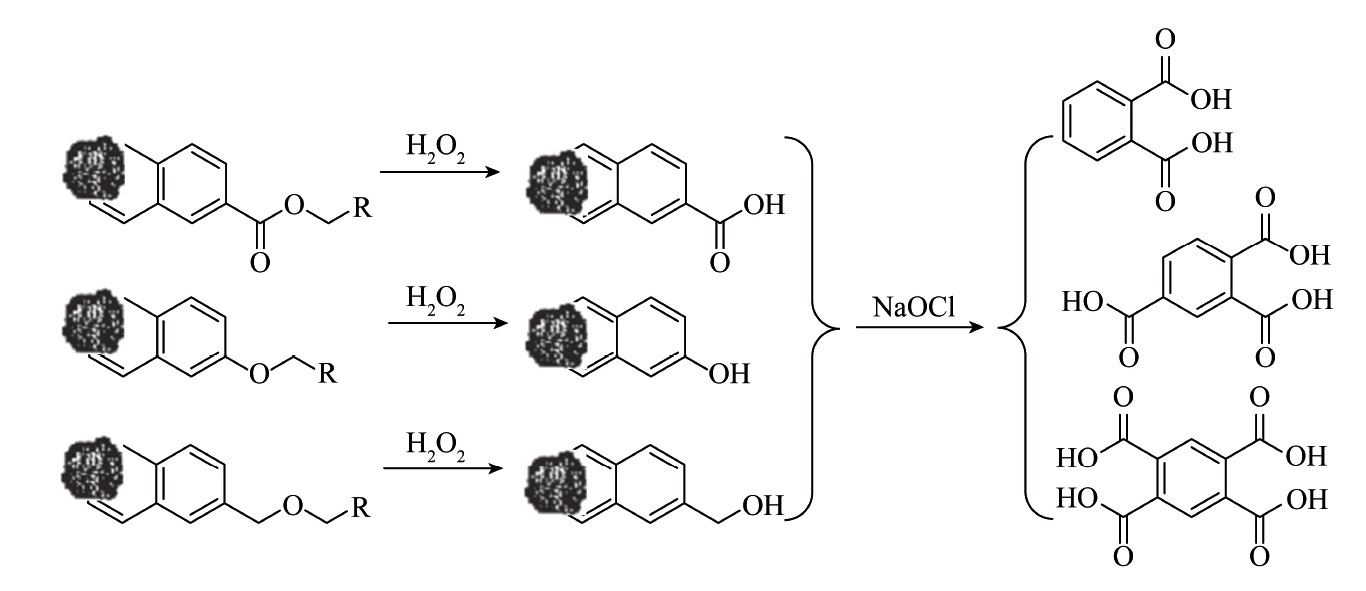The implementation of "carbon peak and carbon neutral" policies will greatly limit the fuel-use of coals. The low-rank coal is abundant in China, and it is not only inefficient to use it directly as energy, but also causes greater pollution. It is expected to develop a new process for production of carboxylic acid chemicals as well as expand the utilization of coal resources through the preparation of carboxylic acid chemicals by mild oxidative depolymerization of low rank coal. According to the difference of the methods, mild oxidative depolymerization of low-rank coals can be classified into non-catalytic oxidation (including chemical reagent oxidation and pretreatment oxidation), catalytic oxidation and in-situ oxidation. The development and characteristics of different oxidation methods for producing carboxylic acid chemicals from low-rank coals were mainly summarized. In non-catalytic oxidation, chemical reagent oxidation is easy to be carried out. Whereas it will cost a large consumption of chemical agents and the oxidation process is not easy to be controlled. At the same time, heteroatoms will be introduced into the resulting products for some oxidizing reagents such as nitric acid and sodium hypochlorite resulting in increasing difficulties of product separation. Pretreatment oxidation can improve the yield of products and utilization rate of low-rank coals, while the pretreatment process is relatively complicated. Catalytic oxidation method can speed up the reaction rate, and reduce investment and energy consumption. The stability, selectivity and efficiency of the catalyst need to be further studied, and the catalyst recovery should also be paid more attention. In-situ oxidation is flexible and controllable, which is expected to regulate the oxygen depolymerization process of low-rank coals. In the end, the current problems and future development direction of mild oxidative depolymerization of low-rank coals were discussed.
Research progress and prospects of mild oxidative depolymerization of low-rank coals
 2022 No. 09
2022 No. 09
 576
576 438
438

Authors:
- CHEN Jie
- WANG Yugao
- WANG Zhilei
- SHEN Jun
- NIU Yanxia
- LIU Gang
- SHENG Qingtao

Unit:
- College of Chemical Engineering and Technology,Taiyuan University of Technology

Abstract:

Keywords:
- low-rank coals
- mild oxidative depolymerization
- carboxylic acid chemicals
- chemical reaction

Citation format:
陈杰(1996—),男,山西临汾人,硕士研究生。E-mail:chenjie0601@link.tyut.edu.cn

Chart:

Articles:
--

Citation format:
--

-
Executive director
China Coal Science and Industry Group Co., Ltd
-
Sponsored by
Coal Science Research Institute Co., Ltd
Coal Industry Clean Coal Engineering
Technology Research Center -
Editor in Chief
XIE Qiang
-
Vice Editor-in-Chief
YU Chang
SHI Yixiang
ZHAO Yongchun
DUAN Linbo
CAO Jingpei
ZENG Jie -
Publication Frequencies
Monthly
-
ISSN
1006-6772
-
CN
11-3676/TD
Covered by
- CSTPCD
- RCCSE(A+)
- AJ
- EBSCO host
- Ulrichsweb
- JST
- Scopus
Contact us
New Media
-
 Meichuanmei
Meichuanmei -
 Clean Coal Technology
Clean Coal Technology -
 Online Journals
Online Journals













 Submission system
Submission system Copyright agreement
Copyright agreement Instructions for authors
Instructions for authors